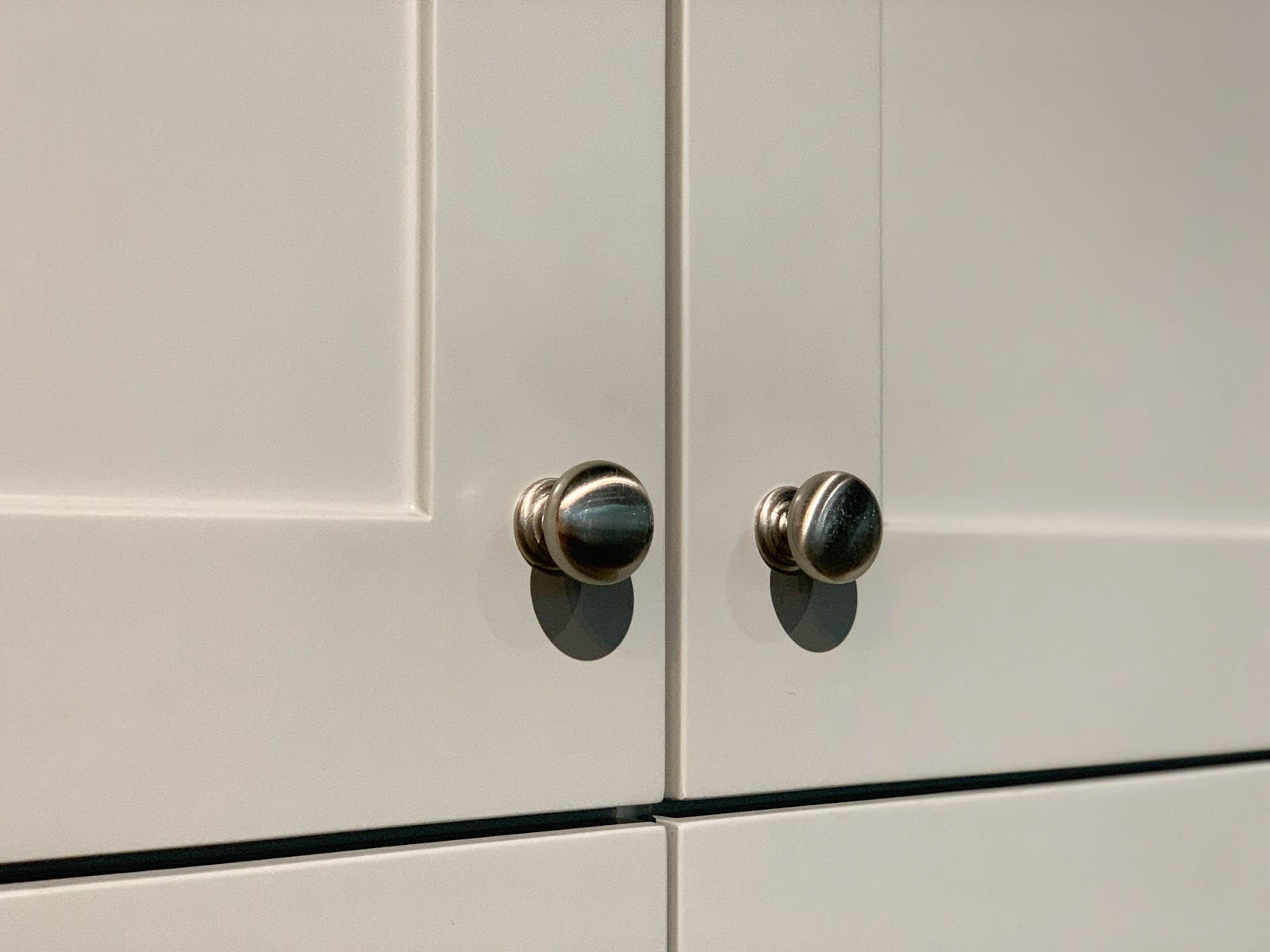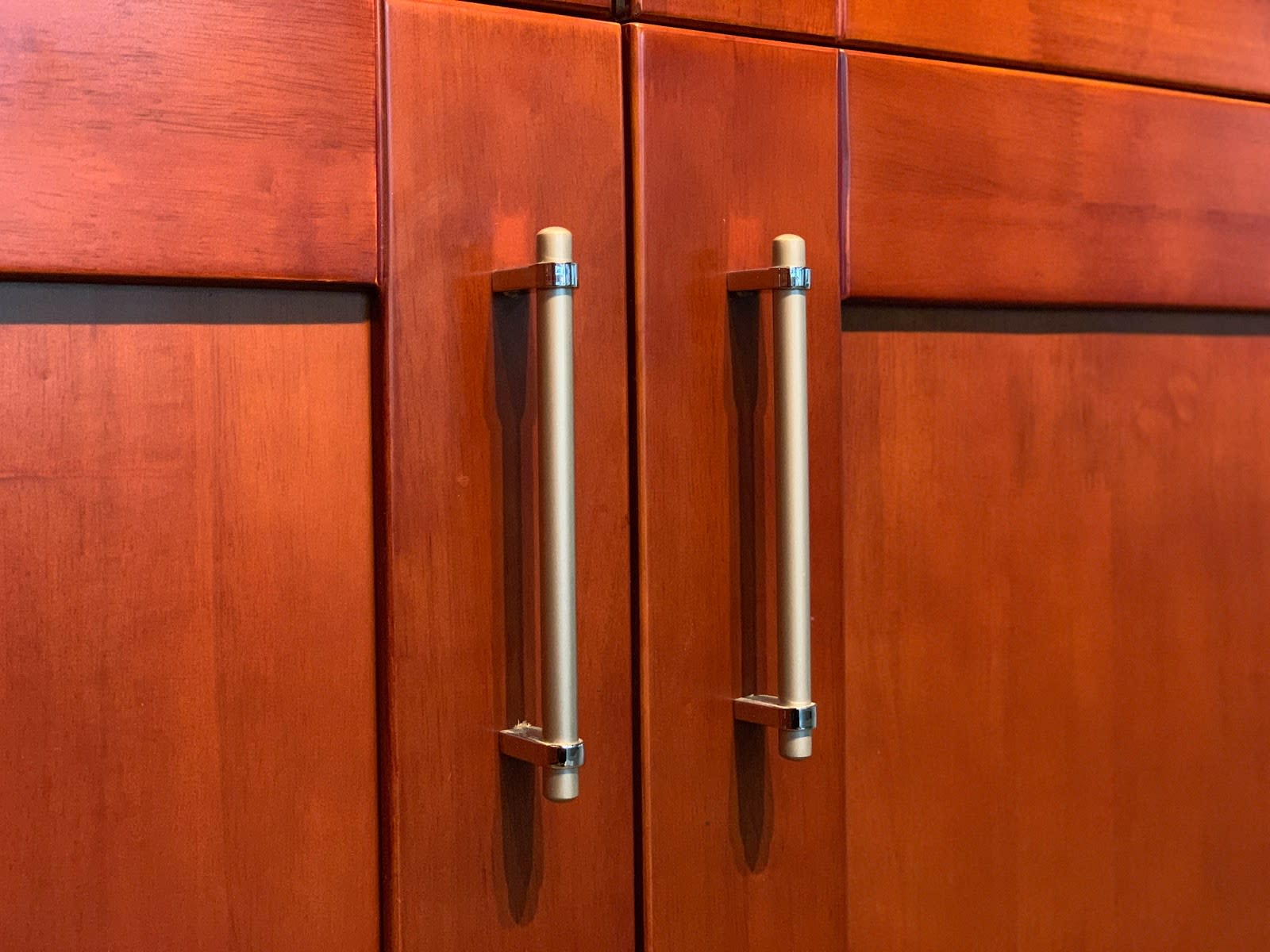Types of Door Handles for Shaker Cabinets

Shaker cabinets, known for their clean lines and simple elegance, benefit from carefully chosen hardware to complete their aesthetic. The right door handle can elevate the overall design, while the wrong choice can detract from it. Selecting appropriate handles involves considering style, material, size, and the cabinet’s finish.
Shaker Cabinet Handle Styles and Materials
A variety of handle styles complement the Shaker aesthetic. Cup pulls, knobs, and bar pulls are popular choices, each offering a unique visual impact. Cup pulls, typically 3-5 inches long and 1-2 inches wide, provide a recessed grip, offering a minimalist yet functional design. They are often made from materials such as brushed nickel, polished chrome, or oil-rubbed bronze. Knobs, available in a wide range of diameters (1-3 inches), offer a classic and versatile option. Materials range from ceramic and glass to metal alloys like zinc and stainless steel. Bar pulls, usually ranging from 6-12 inches in length and 1-1.5 inches in height, offer a sleek, modern feel. These are commonly found in materials such as stainless steel, aluminum, and black matte finishes.
Aesthetic Appeal of Handle Styles with Shaker Cabinets
The choice of handle style significantly impacts the overall look of Shaker cabinets. For example, cup pulls offer a subtle elegance, well-suited to more traditional Shaker designs or those with lighter finishes such as white or cream. Their understated presence allows the cabinet’s clean lines to remain the focal point. Knobs, especially smaller ones, can create a more delicate and refined appearance, suitable for smaller kitchens or bathrooms. Larger knobs can add a touch of rustic charm. Bar pulls, on the other hand, lend a contemporary feel, particularly effective with darker cabinet finishes like espresso or charcoal. The sleek lines of bar pulls create a modern contrast to the classic Shaker style. A polished chrome bar pull on a white Shaker cabinet will create a crisp, clean, and modern look, while a dark bronze cup pull on a dark wood Shaker cabinet would enhance the richness and depth of the wood.
Installation Process for Shaker Cabinet Door Handles
Installing shaker cabinet door handles is a straightforward process, requiring basic tools and techniques. The specific steps vary slightly depending on the handle type.
| Handle Type | Tools Needed | Steps | Tips |
|---|---|---|---|
| Cup Pull | Screwdriver (Phillips or flathead), pencil, measuring tape | 1. Mark the placement of the cup pull on the cabinet door. 2. Pre-drill pilot holes to prevent splitting the wood. 3. Attach the cup pull using the provided screws. | Ensure consistent spacing between cup pulls for a symmetrical look. Use a level to ensure accurate placement. |
| Knob | Screwdriver (Phillips or flathead), pencil | 1. Mark the placement of the knob on the cabinet door. 2. Insert the knob stem through the door and attach the mounting nut on the inside. | Tighten the mounting nut securely to prevent the knob from becoming loose. |
| Bar Pull | Screwdriver (Phillips or flathead), pencil, measuring tape, level | 1. Mark the placement of the bar pull on the cabinet door. 2. Pre-drill pilot holes. 3. Attach the bar pull using the provided screws. | Use a level to ensure the bar pull is installed straight. Consider the distance between the bar pull and adjacent cabinets or appliances for ergonomic access. |
Choosing the Right Door Handle: Door Handles For Shaker Cabinets

Selecting the perfect door handle for your shaker cabinets involves careful consideration of both material and finish. The right combination will not only enhance the functionality of your cabinets but also significantly impact the overall aesthetic of your kitchen, reflecting your personal style and creating the desired ambiance. The choices available are vast, offering a spectrum of durability, maintenance requirements, and visual appeal.
Handle Material Properties
The material of your door handle directly influences its durability, maintenance needs, and cost. Each material possesses unique characteristics that should be weighed against your budget and desired aesthetic.
- Brass: Known for its luxurious appearance and inherent durability, brass handles can withstand daily wear and tear. They develop a beautiful patina over time, adding character. However, they require regular polishing to maintain their shine and can be more expensive than other options.
- Pros: Durable, luxurious appearance, develops patina.
- Cons: Requires polishing, relatively expensive.
- Stainless Steel: A popular choice for its resilience, stainless steel handles are highly resistant to corrosion and scratches. They are relatively easy to clean and maintain, making them a practical option for busy kitchens. The cost is moderate.
- Pros: Durable, resistant to corrosion and scratches, easy to clean, moderate cost.
- Cons: Can show fingerprints, less luxurious appearance than brass.
- Nickel: Offering a sleek, modern look, nickel handles are durable and relatively easy to maintain. They are less prone to tarnishing than brass but still require occasional cleaning. The cost falls within a mid-range.
- Pros: Durable, sleek appearance, relatively easy to clean, mid-range cost.
- Cons: Can show fingerprints, less resistant to scratches than stainless steel.
- Ceramic: Ceramic handles offer a unique, often handcrafted look, adding a touch of artistry to shaker cabinets. While visually appealing, they are more fragile than metal handles and require careful handling to avoid chipping or breakage. Maintenance is minimal, but repairs can be costly.
- Pros: Unique appearance, minimal maintenance.
- Cons: Fragile, prone to chipping, can be expensive to repair.
Finish Impact on Shaker Cabinet Aesthetics
The finish of your door handle significantly influences the overall look and feel of your shaker cabinets. Different finishes complement various kitchen styles, creating distinct ambiances.
Brushed nickel offers a subtle, sophisticated look, working well in transitional and contemporary kitchens. Polished chrome provides a sleek, modern feel, ideal for minimalist or ultra-modern spaces. Oil-rubbed bronze adds warmth and a rustic charm, complementing traditional or farmhouse-style kitchens.
Kitchen Design Scenarios
- Scenario 1: Modern Minimalist Kitchen – Stainless steel handles with a polished chrome finish. The clean lines and reflective surface of the stainless steel and chrome create a sleek, uncluttered look, enhancing the minimalist aesthetic of the shaker cabinets and the overall kitchen design. The polished chrome adds a touch of sophistication, reflecting light and enhancing the sense of spaciousness.
- Scenario 2: Rustic Farmhouse Kitchen – Brass handles with an oil-rubbed bronze finish. The warm tones of the oil-rubbed bronze complement the natural wood tones often found in farmhouse kitchens. The slightly distressed look of the finish adds character and authenticity, creating a cozy and inviting ambiance. The brass itself adds a touch of elegance that elevates the overall feel.
- Scenario 3: Transitional Kitchen – Nickel handles with a brushed nickel finish. The brushed nickel finish provides a subtle sophistication that works well in transitional kitchens, which blend traditional and modern elements. The understated elegance of the nickel complements the clean lines of the shaker cabinets without being overly flashy. The muted finish creates a calming atmosphere, making the kitchen feel both stylish and functional.
Installation and Maintenance of Shaker Cabinet Handles
Installing and maintaining shaker cabinet handles involves a straightforward process, but careful attention to detail ensures a professional finish and longevity. This section details both installation methods and provides guidance on cleaning and maintaining various handle materials to preserve their appearance and functionality.
Installing Shaker Cabinet Handles
Two primary methods exist for installing shaker cabinet handles: screw-on and through-bolt. Both require precise measurements and careful handling to avoid damage.
Screw-on Handle Installation, Door handles for shaker cabinets
- Mark the Handle Position: Hold the handle against the cabinet door where you desire placement. Mark the screw holes using a pencil. Ensure the handle is level and centered.
- Pre-Drill Pilot Holes (Optional): For harder woods, pre-drilling pilot holes slightly smaller than the handle screws prevents wood splitting. This step is particularly crucial for thinner cabinet doors.
- Attach the Handle: Align the handle with the marked holes and insert the screws. Tighten the screws firmly, but avoid over-tightening which could strip the wood or damage the handle.
- Check Alignment: Inspect the handle to ensure it is level and straight. Make adjustments if necessary before the screws are fully tightened.
Illustrative Description: Imagine a simple line drawing showing a cabinet door with a handle positioned centrally. Two small dots represent the screw holes, and arrows indicate the direction of screw insertion. The final image shows the handle firmly attached and level.
Through-Bolt Handle Installation
- Mark the Handle Position and Drill Holes: Position the handle and mark the locations for both the through-bolt and the securing nut. Drill pilot holes for the through-bolt, ensuring the hole size is appropriate for the bolt diameter. A slightly larger hole may be needed for the nut.
- Insert the Through-Bolt: Insert the through-bolt from the outside of the cabinet door, through the handle, and into the pre-drilled hole.
- Attach the Nut and Tighten: Secure the nut on the inside of the cabinet door. Tighten the nut firmly but carefully to avoid damaging the handle or cabinet door.
- Check Alignment: Verify the handle’s level and alignment. Make minor adjustments if needed before fully tightening the nut.
Illustrative Description: A line drawing showing the cabinet door with the handle positioned. One hole is marked on the outside and a larger hole on the inside of the door. The through-bolt is depicted passing through the handle and into the holes. The final image shows the nut tightened on the inside, securing the handle.
Tips for Proper Alignment and Damage Prevention
Proper installation minimizes the risk of damage and ensures a professional look.
- Measure Twice, Drill Once: Accurate measurements are critical to prevent misalignment and ensure the handle is positioned correctly.
- Use the Right Size Drill Bit: Using an appropriately sized drill bit prevents the hole from being too large or too small, potentially damaging the wood or the handle.
- Avoid Over-Tightening: Over-tightening screws or nuts can strip the wood or damage the handle. Tighten firmly, but not excessively.
- Use a Level: A level ensures the handle is installed straight and parallel to the cabinet door.
Maintaining and Cleaning Shaker Cabinet Handles
Different handle materials require specific cleaning methods to prevent damage and maintain their appearance. Regular cleaning and appropriate care prolong the life of your cabinet handles.
Handle Material Cleaning Guide
| Handle Material | Cleaning Method | Issues and Solutions |
|---|---|---|
| Brass | Mild soap and water; brass polish for tarnish | Tarnish: Use a brass polish; Corrosion: Clean promptly and apply a protective sealant. |
| Stainless Steel | Mild soap and water; stainless steel cleaner for stubborn marks | Fingerprints: Wipe with a microfiber cloth; Corrosion: Avoid harsh chemicals. |
| Nickel | Mild soap and water; nickel polish for tarnish | Tarnish: Use a nickel polish; Corrosion: Protect from moisture. |
| Chrome | Mild soap and water; glass cleaner for shine | Water spots: Dry immediately; Corrosion: Avoid abrasive cleaners. |
